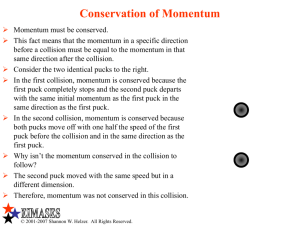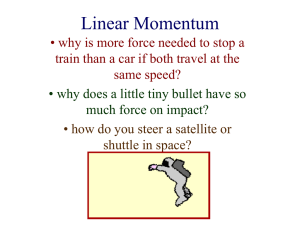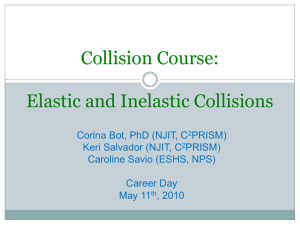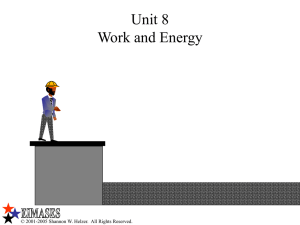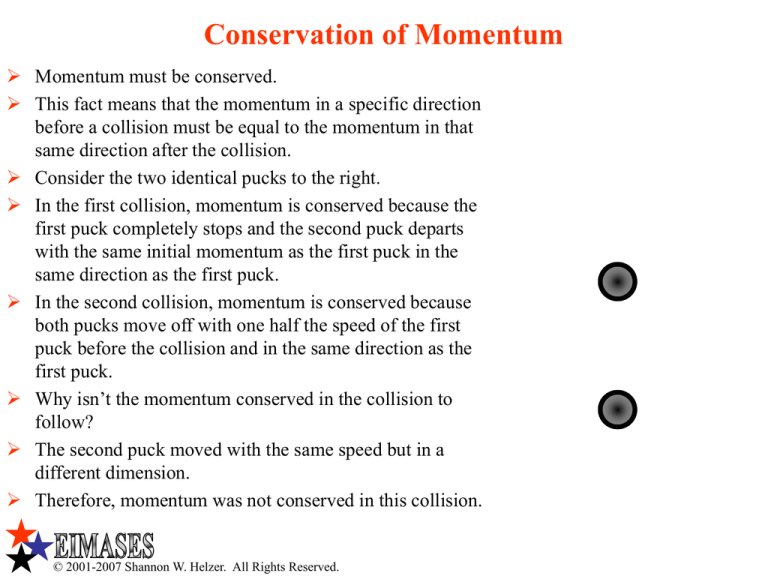
Conservation of Momentum
Momentum must be conserved.
This fact means that the momentum in a specific direction
before a collision must be equal to the momentum in that
same direction after the collision.
Consider the two identical pucks to the right.
In the first collision, momentum is conserved because the
first puck completely stops and the second puck departs
with the same initial momentum as the first puck in the
same direction as the first puck.
In the second collision, momentum is conserved because
both pucks move off with one half the speed of the first
puck before the collision and in the same direction as the
first puck.
Why isn’t the momentum conserved in the collision to
follow?
The second puck moved with the same speed but in a
different dimension.
Therefore, momentum was not conserved in this collision.
© 2001-2007 Shannon W. Helzer. All Rights Reserved.
Momentum – Elastic Collisions
Elastic Collision – a collision in which the colliding bodies do not
stick together.
The equation used for elastic collisions is as follows.
m1v1I m2v2 I m1v1F m2v2 F
© 2001-2007 Shannon W. Helzer. All Rights Reserved.
Momentum – Inelastic Collisions
Inelastic Collision – a collision in which the colliding bodies stick
together.
The equation used for elastic collisions is as follows.
m1v1 m2v2 MVF
© 2001-2007 Shannon W. Helzer. All Rights Reserved.
Momentum
Identify the number and types of collisions in the animation below.
m1v1I m2v2 I m1v1F m2v2 F
© 2001-2007 Shannon W. Helzer. All Rights Reserved.
m1v1I m2V2 I MVF
Momentum
Identify the number and types of collisions in the animation below.
© 2001-2007 Shannon W. Helzer. All Rights Reserved.
Momentum
Identify the number and types of collisions in the animation below.
© 2001-2007 Shannon W. Helzer. All Rights Reserved.
Momentum
Identify the number and types of collisions in the animation below.
© 2001-2007 Shannon W. Helzer. All Rights Reserved.
Momentum – Elastic Collisions WS 27 -1
What type of collision is depicted in the collision of the offensive paddle
and the hockey puck?
What about the collision with the defensive paddle?
If the offensive paddle (m = 0.5 kg) was traveling at 0.75 m/s before the
collision and 0.25 m/s after the collision, then how fast was the puck ( m =
0.2 kg) moving after the collision?
m1v1I m2v2 I m1v1F m2v2 F
© 2001-2007 Shannon W. Helzer. All Rights Reserved.
m1v1I m2V2 I MVF
Momentum – Elastic Recoil Collisions
Recoil can be understood by considering the result of the explosion of
the gun powder on a gun.
The bullet flies in one direction while the gun recoils in the other
direction.
© 2001-2007 Shannon W. Helzer. All Rights Reserved.
Momentum – Inelastic Collisions WS 27 - 2
An explosive bowling ball (m1 = 10 kg, v1I = 10.0 m/s) rolls towards a
gun as shown. The gunman hopes to keep the ball away by shooting a
bullet (m2 = 1.1 kg, v2I = 95.0 m/s) into the ball.
What type of a collision is the one depicted here?
What is the final velocity of the bowling ball?
m1v1I m2v2 I m1v1F m2v2 F
© 2001-2007 Shannon W. Helzer. All Rights Reserved.
m1v1 m2V2 MVF
Momentum – Inelastic Collisions
WS 28 #1
m1v1I m2v2 I m1v1F m2v2 F
© 2001-2007 Shannon W. Helzer. All Rights Reserved.
m1v1I m2V2 I MVF
Two Dimensional Elastic Collision – WS 12 #2
Elastic Collision: A q-ball (m = 0.6 kg) collides with an eight ball (m =
0.7 kg) that was initially at rest. The initial velocity of the q-ball was V1I =
1.2 m/s. After the collision, the q-ball moves away with a velocity V1F =
0.6 m/s at an angle of 45. Determine the velocity, V2F, of the eight ball
after the collision.
P2 I 0
P2 F
P1I
P1F
© 2001-2007 Shannon W. Helzer. All Rights Reserved.
Two Dimensional Elastic Collision
Draw vector diagrams showing the
resultant velocities of the colliding
bodies.
This procedure is the same one used
when solving force problems using
free body diagrams.
P2 I 0
P2 F
m1v1I m2v2 I m1v1F m2v2 F
m1v1Iy m2v2 Iy m1v1Fy m2v2 Fy
m1v1Ix m2v2 Ix m1v1Fx m2v2 Fx
© 2001-2007 Shannon W. Helzer. All Rights Reserved.
P1Fx
P1F
P2Fx
P1Fy
P2Fy
P1I
Two Dimensional Inelastic Collision – WS 12 #1
Inelastic Collision: A bullet (m = 0.15 kg) collides with a bowling ball (m
= 6.0 kg) that was initially moving at a velocity of v2I = 0.75 m/s due left.
The initial velocity of the bullet was v1I = 145 m/s at an angle of 35. The
bullet sticks inside of the ball. Determine the velocity, VF, after the
collision.
P1I
P2I
PF
© 2001-2007 Shannon W. Helzer. All Rights Reserved.
Two Dimensional Inelastic Collision
Draw vector diagrams showing
the resultant velocities of the
colliding bodies.
This procedure is the same one
used when solving force
problems using free body
diagrams.
m1v1I m2v2I MVF
m1v1Ix m2v2 Ix MVFx
m1v1Iy m2v2Iy MVFy
P1I
PFx
P2 Ix
PFy
PF
P2I
© 2001-2007 Shannon W. Helzer. All Rights Reserved.
P2 Iy
Momentum (WS 12 #3)
A bowling ball (m = 8.50 kg, v = 4.00 m/s @ 12.5) strikes a bowling pin (m = 1.80
kg) initially at rest.
After the collision, the pin has a velocity of 9.85 m/s @ 45.0.
What is the final velocity of the bowling ball?
© 2001-2007 Shannon W. Helzer. All Rights Reserved.
Momentum – Elastic Collision Example (WS 12 - 4)
Three identical hockey pucks on a
frictionless air table have repelling magnets
attached.
They are initially held together and then
released.
What is the initial momentum of this
system?
Each has the same speed at any instant.
One puck moves due North.
In which directions do the other two pucks
move?
m1v1I m2v2 I m1v1F m2v2 F
m1v1I m2v2I MVF
© 2001-2007 Shannon W. Helzer. All Rights Reserved.
Intersection Collision Problems – WS 13 - 1
Two cars approach an intersection
with a malfunctioning stop light.
The red car (m = 2000.00 kg)
approaches the intersection from the
North.
The blue car (m = 2250.00 kg)
approaches the intersection from the
West at the speed limit (40.0 km/hr)
on both roads.
Cars are designed to collide inelastically in order to minimize
injury to passengers.
After the collision, the cars move at
a velocity of 31.7 km/hr @ -48.01.
If you were the police officer
investigating the accident, then
would you write one of the drivers a
citation? Explain your answer.
© 2001-2007 Shannon W. Helzer. All Rights Reserved.
Momentum – Elastic Collisions – WS 13 - 2
The defender below tries to stop the puck by pushing his paddle (m = 0.50
kg) across the table at a velocity of 0.60 m/s at 88.55.
After the collision, the paddle moves at a velocity of 0.25 m/s at -85.98,
and the puck (m = 0.20 kg) moves at a velocity of 3.05 m/s at 44.00.
Is the puck speed shown on the laser speed detector correct?
Justify/explain your answer.
© 2001-2007 Shannon W. Helzer. All Rights Reserved.
Momentum – WS 13 - 3
While climbing a cliff, a super model (m = 51.0 kg)
slips and falls.
She falls 35.00 m before she is rescued by Super
Doctor Physics (m = 63.0 kg, v = 27.85 m/s @ 130).
What was their velocity immediately after the
collision?
© 2001-2007 Shannon W. Helzer. All Rights Reserved.
This presentation was brought to you by
Where we are committed to Excellence
In Mathematics And Science
Educational Services.
© 2001-2007 Shannon W. Helzer. All Rights Reserved.

